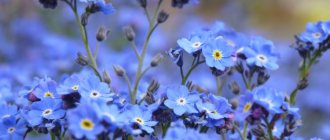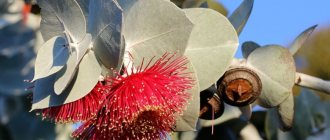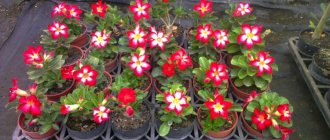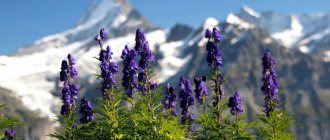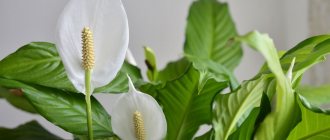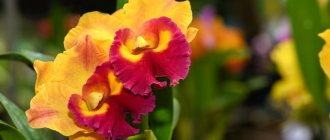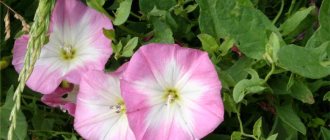Description, features
The height of a bush in adulthood depends on the conditions in which it grew. The range ranges from 15 to 130 cm. Some specimens grow five meters tall, but this is rare. The length of the highly branched roots is approximately ten meters. The dark green leaves are evenly spaced, with their edges curling upward. On the underside of the leaf blades there is a reddish-brown fluff. There are also glands containing essential oil substances. The stems are recumbent, with many ascending branches.
The shrub is very beautiful, but poisonous. In beauty it can be compared with Japanese sakura. Flowers are white or pink. They are dense, five-leafed, located on thin stalks. They bloom in late spring and are good honey plants. However, it should be remembered that collected honey is also poisonous and is suitable for consumption only by the bees themselves.
During the flowering period, esters are released into the air in high concentrations. They are harmful to animals and people because they contain poison that affects the nervous system. After even a short stay near a blooming wild rosemary, characteristic symptoms of poisoning appear. Among them:
- nausea;
- vomit;
- weakness;
- headache;
- dizziness;
- loss of consciousness.
Animals prefer to avoid areas where the plant is located. But sometimes cases of poisoning happen to them too. Most often, hunting dogs become victims.
The fruits are multi-seeded capsules with five nests. Winged seeds are very small in size. Their ripening occurs in the second half of summer.
How to choose the right place and soil?
The ideal option is damp areas. Additionally, it is worth taking care of shading. Ledum does not tolerate scorching sun rays. If thujas or spruces grow in the garden, you can safely plant wild rosemary next to them. The result will be an excellent decorative effect.
It is better to select loose soil with a high acidity level (pH 3 – 4). The planting mixture consists of three essential components: peat, coniferous soil and sand.
Ledum plantations in the country should not be placed near the apiary. Bees love this plant, but the collected nectar carries toxic substances that will spoil all the honey. It will become unsafe for people to consume. You'll have to resort to boiling.
Landing
The shrub must grow and develop in suitable conditions. It does not like bright sunlight, so it is preferable to plant it in the shade. This is an oligotrophic plant that prefers poor and acidic soils. Some species are able to grow on depleted soil with a sandy structure. When selecting a site, you should take into account that this is a perennial that will not have to be replanted for a long time.
The best time to plant wild rosemary is spring. However, if the specimen has a closed root system, then the season does not matter much.
Recommendations:
- Each bush is placed in a pre-dug hole (to a depth of 40 to 50 cm).
- The pit must be filled with the mixture. Its composition: sand (or small pebbles), soil from under coniferous plants (or tree bark), peat.
- A certain interval between plants must be maintained - 50-70 cm.
- After planting, the bushes need to be mulched with pine needles or sawdust.
Ledum plant, where does it grow?
Ledum is a cold-resistant plant. It can be found in forest and tundra zones, in coniferous swampy forests, forest belts at the foot of mountains, along river valleys and peat bogs. The shrub grows well in poor and acidic soils with strong moisture.
Ledum is distributed throughout Central and Northern Europe. It is found in Japan, China and North America. Significant areas of this unpretentious flowering plant are also found in Central Europe. Where does wild rosemary grow in Russia? Most often it is found in the north of the European part of our country, in Eastern and Western Siberia, as well as in the Far East. In addition, this type of flowering shrub is widespread in the foothills of the Sayan Mountains and Eastern Altai.
Care
This is an unpretentious and cold-resistant plant. It needs: watering, fertilizing with fertilizers (with a mineral composition), loosening the soil, pruning.
To maintain optimal soil acidity, you need to water the wild rosemary with acidified water 2-3 times a month. Frequent watering is required during dry and hot periods. 5-8 liters of water should be poured under each bush.
No special pruning required. Only broken, diseased and dry branches should be removed.
It is necessary to loosen the soil very carefully so as not to harm the root system located too close to the surface.
For feeding use ammonium nitrate, urea or ammonium sulfate.
Tips for care and reproduction
Experienced gardeners living in places where wild rosemary grows give the following recommendations:
- The plant is unpretentious to lighting, it will grow even in a shady place and will not die, only the flowers will be slightly smaller.
- The easiest way to propagate is by dividing the bush.
- Abundant watering is necessary only in severe drought.
- You should not grow wild rosemary in small front gardens or near apiaries. Honey collected from the flowers of the plant can cause poisoning.
When planting creeping wild rosemary, no care is required. It grows on rocky slopes and reproduces well by seeds.
Reproduction
The shrub reproduces both by seeds and by vegetative means.
Seeds
In early spring, freshly collected seeds are sown in boxes on a substrate without deepening. Then cover the containers with glass (or film) and put them in a cool place. They must be ventilated every day and the glass must be wiped. Watering is carried out with water from a spray bottle. Seed germination occurs in about a month.
Vegetative methods (cuttings, bushes, layering)
Let's consider all three methods:
- Cuttings. The most complex procedure, which is rarely used because it requires knowledge and skills. Preparation of cuttings is carried out in the summer. The shoots are cut into small sizes ─ 6 cm in length. The lower leaves should be trimmed, leaving only the upper ones. In order to successfully root the cuttings, they are kept for a day in a heteroauxin solution, then washed and planted on the site. Rooting will occur only next spring.
- Bushes. Adult wild rosemary is divided into small seedlings and planted in open ground.
- Layerings. Thin branches must be tilted and rooted next to the mother bush (to a depth of at least twenty centimeters). The middle part is sprinkled with soil, and the inclined branch is partially placed in the hole.
Types and varieties of plants, appearance
Swamp wild rosemary is a shrub whose flowers you can see in the photo. It has medicinal properties and a fragrant aroma. The wild rosemary flower is a beautiful plant that comes in rich purple, pink or plain white.
In different regions you can find different variations and types of wild rosemary. You will definitely remember it when you see it for the first time, because this flowering shrub looks really impressive. Ledum is an evergreen shrub. In addition to its bright, showy flowers when in bloom, wild rosemary has a noticeable brown felt-like fuzz on its branches. But this feature is found only in young shrubs, while mature plants have no pile and the color of wild rosemary is grayer than brown.
This plant reaches a height of up to one hundred and thirty centimeters. The lowest type of wild rosemary is only fifteen centimeters. The leaves of wild rosemary are arranged clearly one after another, evenly, and the leaf blades are bent inward. The top of the leaves is dark green and smooth, and the bottom is covered with brown (sometimes red) fluff. It is in the area at the bottom of the leaf that the essential oil glands of wild rosemary can be seen.
These flowers are pollinated by various insects. For bees, the nectar they get from these flowers is poison. As well as for humans, honey formed in flowers will be poisonous.
There are several types of wild rosemary, for example, Far Eastern or Greenland wild rosemary, depending on the territory of origin. There is also a subspecies of the Transbaikal and common wild rosemary. Some grow in particularly cool places, others in temperate climates. Frost and Siberian wild rosemary are less common than others. Many people do not know when wild rosemary blooms. Everything is quite simple - it blooms in the spring, from May to June.
Kinds
In total, there are about ten species of wild rosemary, four of which grow in our country. More details about them:
- Bolotny. The most famous species both in natural conditions and in culture. Prefers moderate climatic conditions. Grows in highlands, tundras, swampy soils, and permafrost areas. Its other names are forest rosemary, bug grass, gologolom, bagoong. The height of the compact bush ranges from 50-110 cm. The dark shiny leaves have pointed tips. Flower color is white or light pink.
- Large-leaved. Habitat: Japan, Korea and the Far Eastern region. The bush reaches a height of 1.5 meters. Places of growth: heather thickets, mountain coniferous forests, sphagnum bogs. The leaves are oval, covered with red hairs. The flowering period occurs in the first summer month. The plant is characterized by increased frost resistance.
- Greenlandic. Distributed throughout the Arctic zone. Favorite places to grow are peat bogs and wet coasts. It is distinguished by creeping and rigid stems. The inflorescences are spherical in shape and decorated with white flowers. The leaf blades are oblong, covered with numerous red-brown or white hairs, and fit tightly to each other. Flowering begins in June and continues throughout July. The species has high frost resistance. When individual shoots freeze, the overall decorativeness of the plant does not suffer. Rarely found in horticulture, mainly in botanical gardens.
- Creeping (prostrate). It received this name because of its small height - from 20 to 30 cm. This is the shortest growing species. Found in North America and the Far East. Habitat: sparse forests, tundra, swamps, hummocks, sandy hills, cedar forest. Small and white flowers are located on a corymbose inflorescence. There are never too many of them, so flowering is sparse. The shoots are equipped with thick, reddish-rusty hairs. The growth rate is extremely slow; it grows about one centimeter per year.
Wild marsh rosemary
This type of wild rosemary belongs to the heather family. From this family, plants belonging to wild rosemaries are distinguished:
- Marsh wild rosemary
- Greenlandic
- large-leaved
Marsh wild rosemary is an evergreen shrub. The height of the shoots reaches 150 centimeters. The shoots are covered with pubescence of a “rusty” color. Individual bushes reach one meter in diameter. The curled, lanceolate, dark, shiny leaves of the bush are curled down. This wild rosemary blooms en masse at the end of May. The flowers are beautiful, white, sometimes light pink, in umbels of many flowers. During flowering, essential substances are released into the atmosphere. These substances have a toxic effect on the human body. During flowering, their concentration in the air reaches its peak. The plant is completely poisonous, not just the flowers. Being near wild rosemary for several minutes, a person begins to experience a severe headache, nausea, and dizziness. You can lose consciousness if you inhale the aroma of wild rosemary for too long.
However, not only the plant is poisonous, even the honey collected from these flowers is poisonous. So, before you start growing this heather for decorative purposes, you need to think about the consequences. Even animals experience exhaustion and weakness after prolonged contact with bushes, as there is multiple evidence from professional hunters. After flowering until mid-June, the period of seed ripening begins.
The capsule-shaped fruit ripens in August. The plant reproduces in two ways: by root shoots and seeds. Ledum is winter-hardy in any conditions. However, shoots on open ground that are not covered with snow die. Shrubs growing in non-snowy areas have a beautiful and even crown shape, as if trimmed by a master. The inflorescences at the edges are larger than in the center. But. Flowering occurs simultaneously. Mass flowering of marsh and other wild rosemaries of the heather family does not occur every year, but once every 4 years. This is due to the long growing season.
Ledum reproduces well by seeds in open forests and areas without moss. Grows slowly in any conditions. The lifespan of the root system is not much more than thirty years. But in mossy, marshy areas, wild rosemary does not survive for long. It is gradually being pulled into the thickness of the moss due to the constant growth and rise in the level of the swamp. As a result, the root system finds itself in conditions deprived of oxygen and in very humid conditions.
Then the roots die off, turning into a thick layer of swamp and peat, and adventitious surface roots appear on living shoots (if any). If the roots are not covered with snow for the winter, then the plant does not survive. When wild rosemary blooms, on a bright moonlit night the landscape appears enchanting and magical. Flowering rosemary bushes, shrouded in an alluring, deceptive and so pleasant aroma, attract you to them. I immediately remember fairy tales about ominous and beautiful swamps, undines, revived drowned women, forest dwellers and magic.
Habitats
The most common is marsh wild rosemary, found everywhere in different parts of the world, where coniferous forests, mountain streams, forest-tundra, mountain thickets, and dwarf cedar forests are located. There is a lot of wild rosemary in the swamps of Belarus.
Medicinal properties
All parts of the plant (except for the rhizome) are rich in essential oil, which is identified by its specific smell. Most medicinal products are based on this component. Also, in the above-ground parts there is also a whole complex of active substances that have a multifaceted effect on the body. These include:
- iceol (sesquiterpene alcohol);
- neomertillin (has an inulin-like effect);
- arbutin (antiseptic);
- tannins (pronounced hemostatic and astringent properties);
- bioflavonoids (have a positive effect on vascular tone).
Ledum contains enzymes, organic acids, vitamins and minerals in small quantities.
In folk medicine it is rightfully recognized as a universal medicine. Has the following medicinal properties:
- painkillers;
- anti-inflammatory;
- diuretic;
- disinfectants;
- sedative;
- anticonvulsants.
The plant is widely used in medical practice. It is used in the form of decoctions, infusions, alcohol tinctures, ointments, drops, oils.
For example, it helps with cough, as it relaxes the smooth muscle tissue of the bronchi, promotes abundant secretion and removal of sputum. And for fever, it has been used since ancient times as an effective diaphoretic.
There are many more diseases and pathological conditions for which wild rosemary is used. Here is the detailed list:
- bronchitis;
- laryngitis;
- acute respiratory viral infections;
- bronchial asthma;
- tuberculosis;
- gout;
- urinary tract diseases;
- arthritis and arthrosis;
- pneumonia;
- hypertonic disease;
- intestinal dysbiosis;
- spastic enterocolitis;
- rheumatism;
- eczema, furunculosis.
Research has proven that medicines based on this plant are not addictive. For this reason, doctors may prescribe them for a long period of time.
Benefit
It contains a large number of essential oils of complex composition, as well as various tannins, flavonoids and glycosides. Ledum is used as a remedy to reduce pain from problems such as rheumatism, arthritis or gout. Tinctures and decoctions are made from it, as well as oil extracts for rubbing.
A decoction of wild rosemary leaves has diaphoretic and diuretic properties. And tinctures from the leaves help with diseases of the upper respiratory tract, promote expectoration and soften the throat. Also, wild rosemary essential oils can fight Staphylococcus aureus bacteria.
The marsh wild rosemary herb is often dried in order to soften attacks of bronchial asthma with the help of these dried flowers. Asthmatics are advised to keep a bag of dried wild rosemary herbs in their room to prevent the onset of asthma. The smoke from burnt wild rosemary leaves acts as a good sedative.
Landscape design
The perennial grows well under trees and on rocky embankments. Landscape designers use it to create beautiful compositions near bodies of water (lakes, rivers). Looks good with decorative spruce trees, thujas and other small conifers.
It also looks very attractive in garden plots. Of course, you can’t plant it near your house or in places where people often stay. But you can use the bush as a hedge. It will destroy harmful bacteria in the air and repel annoying insects (mosquitoes and flies) from the area. Creeping species are suitable for decorating rock gardens and rocky gardens.
Cultivating wild rosemary is not at all difficult. If you plant it in the right place in accordance with all the requirements, then all that remains is to enjoy the unusual and luxurious flowering of the shrub.
Application
Medicines containing wild rosemary increase heart rate and suppress cough, and also dilate blood vessels (peripheral and coronary). In addition, wild rosemary acts as a good diuretic. However, the use of wild rosemary is not limited to medicine. It is used everywhere, both in everyday life and cooking, and as a means for weight loss. You will learn more about this below.
In cooking
Ledum has a pronounced spicy aroma, and is often called forest rosemary. Actually, in cooking it is used in much the same way. Breads and cakes are prepared with wild rosemary, which slowly deteriorate due to the composition of wild rosemary, and also have a tonic effect. They make jam with wild rosemary, and from the essential oils of rosemary they often brew beer and make vodka.
In medicine
Ledum juice is used as a remedy for bacteria. It is able to overcome viral diseases such as whooping cough or diphtheria, hemolytic streptococcus and luminous vibrio.
Ledum essential oil can reduce cramps, relieve inflammation, accelerate blood flow and relieve spasms. Ledum is used to make compresses for joints, and is also used for neuritis and myositis. Decoctions or tinctures help overcome headaches or diseases of the cardiovascular system, as well as asthma and bronchitis.
When losing weight
Since wild rosemary is a strong diuretic, it is used in this way to get rid of a few extra pounds and remove excess water. However, in this case, a decoction of wild rosemary works only to remove water from the body. In the future, wild rosemary can only worsen the health condition.
At home
Ledum has a rich and spicy aroma that repels both insects and various rodents that are harmful to everyday life. Dried wild rosemary herb will help solve problems with rats and mice, and will also be effective if mosquitoes and flies often appear in your home.
In cosmetology
Ledum is rich in various vitamins, so it can often be found in various creams and masks. The vitamins contained in wild rosemary tone the skin and relieve swelling, as well as nourish and cleanse. However, independent use of wild rosemary in cosmetology will be dangerous, so it is better to simply purchase ready-made folk cosmetics created by specialists.
Growing wild rosemary
Ledum, due to its specific properties, is not often used for growing in personal plots. However, if you decide to decorate your area with it, then wild rosemary is suitable for cultivation in the garden. You should not dig it up in the swamp and plant it on the site, as it will die. It is best to purchase it at a nursery. The plants exhibited there are already adapted to the conditions of the garden plot. Planting and caring for wild rosemary is not difficult. He is not whimsical and does not require much trouble. Favorable time for planting is spring. For planting material, you need to make a hole 40 cm deep. To create a composition, you can place several bushes at a distance of 50 cm from each other. Where wild rosemary grows, the soil is usually acidic. Therefore, planting holes are filled with moss peat, coniferous soil and sand. A drainage of sand or pebbles is placed at the bottom, and mulching with peat is done on top.
Sources used:
- https://zakupator.com/sad/bagulnik.html
- https://7ogorod.ru/prochee/bagulnik-bolotnyj.html
- https://sadovnikam.ru/442783a-bagulnik-kogda-tsvetet-gde-rastet-poleznyie-svoystva-i-opisanie-s-foto
- https://cvetnik.me/tsvetushhie/bagulnik-kogda-cvetet
- https://ogorodsadovod.com/entry/2058-kogda-rastsvetet-bagulnik-vse-o-rastenii
- https://domsad.guru/tsvety-rasteniya/b/pic719_tsvet-foto-bagulnik.html
- https://dekorativnye.ru/bagulnik-bolotnyj.html
- https://cvetnik.me/kustarniki/bagulnik
- https://klumba.guru/dikorastuschie-rasteniya/kogda-cvetet-rastenie-bagulnik-i-kak-on-vyglyadit.html
- https://sadovnikam.ru/432005a-bagulnik-gde-rastet-opisanie-s-foto-poleznyie-svoystva-sovetyi-po-razmnojeniyu-i-uhodu
- https://www.syl.ru/article/350414/kogda-tsvetet-bagulnik-opisanie-svoystva-osobennosti-i-otzyivyi
Ledum, intoxicating and healing
Marsh wild rosemary is literally poisonous from top to bottom, but perhaps because of this it has become one of the most famous medicinal plants.
Marsh rosemary. (Photo: Nicholas Hunter / Flickr.com)
‹
›
“Somewhere wild rosemary is blooming on the hills, cedars are piercing the sky...” - these are the words from a song that was once popular and loved by many. But does anyone think about the confusion in the names of plants that happened here? In fact, the song is about the Daurian rhododendron ( Rhododendron dauricum L.
), which in Siberia and the Far East is popularly called wild rosemary. The name “Ledum” has become so firmly entwined with it that one can often come across phrases: “Rhododendron Daurian, or rosemary... Siberian... Far Eastern,” etc. But S. I. Ozhegov’s explanatory dictionary clearly distinguishes real Ledum from fake: “ 1) An evergreen shrub of the heather family with an intoxicating odor, growing in peat bogs. 2) The popular name of a shrub plant with delicate lilac-pink flowers - one of the types of rhododendron.”
Adding to the confusion is the fact that in Western literature, some authors have included all species of the genus Ledum since the 1990s in the genus Rhododendron, but in Russian-language untranslated literature this view has not yet been supported. According to the website “Group of Phylogeny of Angiosperms”, in the modern classification the genus Ledum remains independent and includes 8 species, 4 of which are distributed in Russia. The most widespread representative of the wild rosemary genus in nature is the marsh rosemary, which will be discussed in our material.
Ledum palustre L.
) belongs to the heather family (
Ericaceae
). It is a strongly branched evergreen shrub, 50 to 120 cm high, with ascending shoots covered with thick “rusty” tomentose. The diameter of the bush in adulthood is about 1 meter. The leaves are lanceolate, dark, shiny, fragrant. The edges of the leaves are strongly curled down. The flowers (up to 1.5 cm in diameter) are white, less often pinkish, pungently scented, in multi-flowered umbels. The capsule fruit opens with five doors. The seeds ripen in mid-August. The roots are superficial.
Ledum is a poisonous plant, and the whole of it is poisonous. Its leaves and branches (and especially flowers, pollen and seeds) emit a sharp, specific intoxicating odor, which in large quantities has an adverse effect on a person in the form of developing dizziness, headache, and nausea. This is due to the complex essential oil content in the plant. In the old days, rural innkeepers often infused wild rosemary into moonshine in order to intoxicate the client and extract more money from him.
Marsh rosemary. (Photo: Oleg Mitrofanov)
Ledum is a moisture-loving, frost-resistant, light-loving plant, but it can also grow in partial shade and grows slowly. Like all heathers, wild rosemary is a mycorrhizal plant whose symbiont fungi require acidic soil (“mycorrhizae” are fragile symbiotic cases of fungal hyphae covering the tips of the roots).
The homeland of wild rosemary is the Arctic, East European Plain, Western and Eastern Siberia, Western, Northern, Southern Europe, Northern Mongolia, Northeastern China, Korea, North America. The distribution area is the Arctic, northern zone and northern regions of the temperate zone of Eurasia and North America. On the territory of Russia, the species has a very large range, covering the tundra and forest zones of the European part, Siberia and the Far East. Wild rosemary grows in the tundra and forest-tundra on peat bogs, in high bogs, in the undergrowth of damp coniferous forests, along mountain rivers and streams, in the highlands, in groups, in small thickets, among dwarf cedar trees. Despite the vast Holarctic range of wild rosemary, it “loves” Siberia most of all. In many regions of the European part of Russia, wild rosemary is included in the Red Books (Voronezh, Lipetsk, Penza, Tula, Ulyanovsk regions, Moscow, as well as the republics of Bashkortostan and Tatarstan).
Origin of the Latin name of the plant Ledum
has several versions: according to one version, the name of the genus was borrowed by Linnaeus from Dioscorides, who called another plant genus by the name “ledon” - Cistus, which produces an aromatic resin - incense, similar in smell to the essential oils secreted by wild rosemary.
According to another version, the name comes from the Latin word “laedere”, which means “to harm, torment”, due to the strong suffocating odor that causes dizziness. The Russian name of the plant comes from the Old Slavonic “bagulit”, that is, to poison (all parts of the plant, as we remember, are poisonous). The specific name palustris
, that is, “marsh”, is associated with the place of its growth. Moreover, wild rosemary has many popular names: bagun, bagula, bagunnyak, bogovnik, bagunnik, bugun, swamp hemlock, golovolom, bagno (this is also the name for a low, swampy place), oregano, oregano, kanabornik, marsh ditch, large bugleaf, klopovaya grass, swamp stupor, forest rosemary. All of them accurately reflect the simultaneous toxicity and healing properties of the plant.
There are many legends about wild rosemary. One of them tells the story of a mysterious swamp snake that lives in the taiga of Pomerania and appears when wild rosemary is set on fire. The snake was attracted by the intoxicating smell of the plant, and it absorbed all the aromas of the smoke. And if the snake came across a sick person, it could wrap itself in rings around the person and drive the disease out of him. Another legend about wild rosemary tells of a swamp lord who fell in love with a beautiful forest nymph, but she laughingly rejected his advances. One day, having received another refusal from the beautiful nymph, the ruler became angry, went berserk and began to destroy everything around. From a random spark, the swamp caught fire, and the smoke from the burnt wild rosemary was carried by the wind to the forest where the nymph lived, and stupefied her head. Following the smell of smoke, she came to the swamp itself, where the swamp lord lured her. Since then, it has been believed that if there is fog in the swamp, it means that the nymph, having sobered up, is trying to escape from the ruler, and he creates fog so that she gets lost. And if the swamps are burning, it means that the nymph has run away from the ruler, and he is desperately trying to lure her back to him. Perhaps because of the characteristic aroma of wild rosemary, it was endowed with magical properties. Wild rosemary is held in special esteem among the peoples of the North. According to ancient northern beliefs, the bright smell of wild rosemary drives away evil spirits. Therefore, it was widely used by shamans, developing the gift of clairvoyance and trying to enter a trance. They drank wild rosemary infusion before and during the rituals, and inhaled the smoke of burning branches. A special smoker made from wild rosemary was a mandatory attribute of a shaman, along with a tambourine, a belt and a suit. It is believed that such smoke affects not only the psyche of the shaman, but also of others present during the ritual, and promotes communication with spirits and the transition of consciousness to another dimension. Ledum was also widely used by healers who prepared various love potions with it. Ledum infusions were also used by witches to get rid of unnecessary pregnancy.
In general, judging by popular belief, wild rosemary has magical properties for every taste. Somewhere it was believed that with its help one could inflict madness, summon an evil spirit, somewhere it was considered one of the most effective love potions. Thus, in Carpathian legends it is depicted as a strong love spell. In the Far East there is an ancient belief, vaguely similar to the legend about the fern, that wild rosemary is a magical bush that can talk and knows all the secrets, including where treasures are buried. On a full moon, he can reveal his secret and lead him to the treasure. But he did not show the treasure to everyone, but only to a virgin who would let down her hair and bring him some milk or honey. In the symbolic language of plants, wild rosemary flowers symbolize courage and disregard for death. For centuries, it was believed that wild rosemary strengthens memory and clarity of mind, elevates mood, and protects against evil influences from outside and evil thoughts within.
Despite its poisonous properties, wild rosemary is still a medicinal plant. Since wild rosemary is a plant of the north, it was not known to the ancient world, but since the early Middle Ages it has been mentioned as a medicine in Danish and German herbalists. Since ancient times, diseases of the liver and kidneys, heart and lungs were treated with a decoction of wild rosemary. For the first time, Swedish doctors introduced wild rosemary into European medical practice - there, a decoction of flowers and young shoots of the plant was used to treat gout, bronchitis, dysentery, and skin diseases. The medicinal properties of wild rosemary were described back in the 18th century by the outstanding biologist Carl Linnaeus. Ledum is also mentioned in old Russian herbal books - they said that this remedy is “very powerful, cancer-healing, it quenches pain and breaks up tumors.” In the East Slavic region, wild rosemary has been used as a medicine since the 18th century - early Russian scientists called it “stinking heather.” At this time, a book called “On the Benefits of Stinking Heather” was even published in Russia. Among the people, wild rosemary is a favorite drug; it has long been considered a panacea, used for almost all diseases, and during any epidemics, wild rosemary tea was always drunk for prevention.
Marsh wild rosemary in the vicinity of Lake Kampyurku. (Photo: Oleg Mirofanov)
Different nations have their own peculiarities of using wild rosemary: in the Komi Republic wild rosemary is used to treat excessive addiction to strong drinks; a tincture from the plant is added to the drink so that a person develops an aversion to alcohol. In Transbaikalia and Siberia, tar is made from wild rosemary, which is used to treat eczema by mixing it with sour cream. Ledum is also used in other countries. For example, in France, plant extract is added to ointments and gels against skin diseases. In Bulgaria, hot tincture of wild rosemary flowers is very popular; it is used to treat cholecystitis. The Indians of North America use wild rosemary as a spice, soaking meat in a decoction of its shoots, drinking a heady infusion of rosemary and chewing its fresh leaves.
It is not surprising that wild rosemary is a popular medicinal plant, since its composition is unique. All parts of the plant contain a large amount of tannins, organic acids, vitamins, arbutin glycoside, and flavonoids. The main component of wild rosemary is the essential oil, which includes ledol, palustrol, cymene, geranyl acetate and other components that have a bitter-pungent taste and balsamic odor. The largest amount of essential oil is contained in young leaves during the flowering phase of the plant. True, the chemical composition of wild rosemary, and in particular the content of its main active ingredient - iceol in the essential oil, has pronounced chemical variability depending on the area of growth. The qualitative composition of the essential oil of wild rosemary collected in Europe is practically the same, while the Siberian and Far Eastern populations are heterogeneous in the composition of essential oils.
Ledum essential oil is an effective medicine that helps with cramps, relieves inflammation and increases the resistance of gastric tissues, actively relieves spasms, and can be a good remedy for a runny nose. Ledum oil ointment is prescribed to treat wounds and burns; it also soothes skin itching due to insect bites. In official medicine, wild rosemary herb is used for enterocolitis, in the form of tinctures it is used for diseases of the respiratory system in acute and chronic bronchitis as a vasodilator, a cough softener (antitussive drug “Ledin”, “Chest collection No. 4”), as a diuretic, disinfectant and antiseptic . Ledum preparations are used for diabetes, rheumatism, jaundice (but due to the fact that the plant contains toxic substances, treatment with products based on wild rosemary should be agreed with a doctor, since the plant can cause great harm to the body, and in no case its dosage must not be exceeded).
Ledum is also used in veterinary practice. In particular, it is added to animal feed during epidemic diseases. By the way, despite its toxicity, wild rosemary in the tundra and taiga serves as a significant aid for the nutrition of wild reindeer, but poisoning has been reported in domestic goats and sheep after eating this plant. Decoction, infusion, powder, smoke of wild rosemary is a proven remedy for exterminating mosquitoes, moths and bedbugs, as well as for expelling annoying rodents. Together with tar, essential oil from wild rosemary can be used in leather processing; it can be used in soap making and perfumery, as well as in the textile industry as a fixative.
Finally, all types of wild rosemary are good honey plants. True, they produce a small collection of honey, and besides, wild rosemary honey is poisonous (the so-called “drunk” honey), it cannot be eaten without boiling. So the honey production of wild rosemary only benefits the bees themselves.
Ledum has been introduced into culture since the middle of the 18th century. The first mention of this genus in the catalogs of the Botanical Garden of St. Petersburg dates back to 1736 and, possibly, records the growth of Ledum palustre L.
in the territory of the Apothecary garden in a wild state. This species is very difficult to cultivate, but with the right approach it can be used for decorative purposes in heather parks and gardens, where it can live for more than 30 years.
In the Altai Nature Reserve, wild rosemary is a common species in the lower part of the high-mountain belt. Rarely found in the black and forest-steppe belts. It grows in almost all floristic regions of the reserve, except Yazulinsky, at altitudes of 700–2300 m above sea level, and except in the vicinity of the Baygazan cordon.
Researcher of the Altai Nature Reserve Miroslava Sakhnevich.
State Natural Biosphere Reserve "Altai"
Contraindications
The use of this shrub seems limitless, but for all its beneficial qualities, it also has a number of contraindications. Since this plant is poisonous, it is recommended to use it strictly according to the instructions.
- Strictly contraindicated for pregnant women and while breastfeeding.
- Children under 14 years of age.
- In case of individual intolerance to drugs.
- For hepatitis, hypotension and glomerulonephritis.
- The dosage should be strictly observed to avoid side effects that are detrimental to health.
The use of blooming Ledum in garden decoration
Thanks to its attractive crown with dark green leaves and reddish pubescence, the crop looks incredibly beautiful in the garden. The shrub can be an excellent option for landscaping wet types of soil, ponds, rivers and banks.
Group plantings with such a plant look unusual. Ribbon plantings can serve as a hedge or to zone a space.
You can combine the culture with Heather, Blueberry, Cranberry, Rhododendron, Stachys, and Cereals.
